Optimizing Straw Mulching Methods to Control Soil and Water Losses on Loess Sloped Farmland
Abstract
:1. Introduction
2. Materials and Methods
2.1. Study Area
2.2. Straw Mulch Treatment
2.3. Rainfall Simulation and Plot Establishment
2.4. Field Measurement
2.5. Research Methods and Data Analysis
2.5.1. Improved Merriam Interception Model
2.5.2. Analysis of the Benefits of Water and Sand Reduction
2.5.3. Data Analysis
3. Results
3.1. Interception Process of Different Straw Mulching Methods
3.2. Influence of Different Straw Mulching Methods on the Runoff and Soil Erosion
3.2.1. Initial Runoff Time
3.2.2. Runoff and Soil Erosion Processes
3.2.3. Relationship between Runoff Rate and Sediment Yield Rates
3.2.4. Runoff and Sediment Yields
3.3. The Role of Straw Mulching Parameters on Soil Water Erosion
4. Discussion
4.1. Straw Interception Models for Different Mulching Methods
4.2. Effect of Different Mulching Methods on Rainwater Partitioning
4.3. Effectiveness of Different Straw Mulching Methods in Controlling Soil and Water Losses
4.4. Limitations of This Study
5. Conclusions
Author Contributions
Funding
Data Availability Statement
Acknowledgments
Conflicts of Interest
References
- Souza, T.E.M.d.S.; Souza, E.R.d.; Montenegro, A.A.d.A.; Bayabil, H. Could Forage Palm and Stone Barrier Be as Effective as Native Vegetation in Controlling Runoff and Erosion in the Brazilian Semiarid Region? Agronomy 2023, 13, 3026. [Google Scholar] [CrossRef]
- Li, X.; Wang, X.; Gu, J.; Sun, C.; Zhao, H.; You, S. Temporal and Spatial Variation in Rainfall Erosivity in the Rolling Hilly Region of Northeast China. Agronomy 2023, 13, 2877. [Google Scholar] [CrossRef]
- Liang, X.; Song, K.; Zhang, Y.; Huang, H.; Wang, Y.; Cao, Y. Effects of Different Tillage Practices on Slope Erosion Characteristics of Peanut Field. Agronomy 2023, 13, 2612. [Google Scholar] [CrossRef]
- Rahma, A.E.; Wang, W.; Tang, Z.; Lei, T.; Warrington, D.N.; Zhao, J. Straw mulch can induce greater soil losses from loess slopes than no mulch under extreme rainfall conditions. Agric. For. Meteorol. 2017, 232, 141–151. [Google Scholar] [CrossRef]
- Omidvar, E.; Hajizadeh, Z.; Ghasemieh, H. Sediment yield, runoff and hydraulic characteristics in straw and rock fragment covers. Soil Tillage Res. 2019, 194, 104324. [Google Scholar] [CrossRef]
- Zhang, J.; Duan, L.; Liu, T.; Chen, Z.; Wang, Y.; Li, M.; Zhou, Y. Experimental analysis of soil moisture response to rainfall in a typical grassland hillslope under different vegetation treatments. Environ. Res. 2022, 213, 113608. [Google Scholar] [CrossRef] [PubMed]
- Dey, D.; Gyeltshen, T.; Aich, A.; Naskar, M.; Roy, A. Climate adaptive crop-residue management for soil-function improvement; recommendations from field interventions at two agro-ecological zones in South Asia. Environ. Res. 2020, 183, 109164. [Google Scholar] [CrossRef]
- Yakubu, A.; Sabi, E.B.; Onwona-Agyeman, S.; Takada, H.; Watanabe, H. Impact of sugarcane bagasse mulching boards on soil erosion and carrot productivity. Catena 2021, 206, 105575. [Google Scholar] [CrossRef]
- Chai, Y.; Chai, Q.; Han, F.; Li, Y.; Ma, J.; Li, R.; Cheng, H.; Chang, L.; Chai, S. Increasing yields while reducing soil nutrient accumulation by straw strip mulching in the dryland wheat (Triticum aestivum L.) cropping system of Northwest China. Agric. Ecosyst. Environ. 2022, 326, 107797. [Google Scholar] [CrossRef]
- Foltz, R.B.; Dooley, J.H. Comparison of erosion reduction between wood strands and agricultural straw. Trans. ASAE 2003, 46, 1389–1396. [Google Scholar] [CrossRef]
- Wang, L.; Dalabay, N.; Lu, P.; Wu, F. Effects of tillage practices and slope on runoff and erosion of soil from the Loess Plateau, China, subjected to simulated rainfall. Soil Tillage Res. 2017, 166, 147–156. [Google Scholar] [CrossRef]
- Zhao, X.; Song, X.; Li, L.; Wang, D.; Meng, P.; Li, H. Effect of microrelief features of tillage methods under different rainfall intensities on runoff and soil erosion in slopes. Int. Soil Water Conserv. Res. 2023, in press. [Google Scholar] [CrossRef]
- Savenije, H.H.G. The importance of interception and why we should delete the term evapotranspiration from our vocabulary. Hydrol. Process. 2004, 18, 1507–1511. [Google Scholar] [CrossRef]
- Gerrits, A.M.J.; Savenije, H.H.G.; Hoffmann, L.; Pfister, L. New technique to measure forest floor interception—An application in a beech forest in Luxembourg. Hydrol. Earth Syst. Sci. 2010, 11, 695–701. [Google Scholar] [CrossRef]
- Sun, J.M.; Yu, X.X.; Li, H.Z.; Chang, Y.; Wang, H.N.; Tu, Z.H.; Liang, H.R. Simulated erosion using soils from vegetated slopes in the Jiufeng Mountains, China. Catena 2016, 136, 128–134. [Google Scholar] [CrossRef]
- Parhizkar, M.; Shabanpour, M.; Lucas-Borja, M.E.; Zema, D.A.; Li, S.; Tanaka, N.; Cerdà, A. Effects of length and application rate of rice straw mulch on surface runoff and soil loss under laboratory simulated rainfall. Int. J. Sediment. Res. 2021, 36, 468–478. [Google Scholar] [CrossRef]
- Bulcock, H.H.; Jewitt, G.P.W. Field data collection and analysis of canopy and litter interception in commercial forest plantations in the KwaZulu-Natal Midlands, South Africa. Hydrol. Earth Syst. Sci. 2012, 16, 3717–3728. [Google Scholar] [CrossRef]
- Xia, L.; Song, X.; Fu, N.; Cui, S.; Li, L.; Li, H.; Li, Y. Effects of forest litter cover on hydrological response of hillslopes in the loess plateau of China. Catena 2019, 181, 104076. [Google Scholar] [CrossRef]
- Li, X.; Niu, J.Z.; Xie, B.Y. Study on hydrological functions of litter layers in North China. PLoS ONE 2013, 8, e70328. [Google Scholar] [CrossRef]
- Putuhena, W.; Cordery, I. Estimation of interception capacity of the forest floor. J. Hydrol. 1996, 180, 283–299. [Google Scholar] [CrossRef]
- Marin, C.T.; Bouten, I.W.; Dekker, S. Forest floor water dynamics and root water uptake in four forest ecosystems in northwest Amazonia. J. Hydrol. 2000, 237, 169–183. [Google Scholar] [CrossRef]
- Guevaraescobar, A.; Gonzalezsosa, E.; Ramossalinas, M.; Hernandezdelgado, G.D. Experimental analysis of drainage and water storage of litter layers. Hydrol. Earth Syst. Sci. 2007, 11, 1703–1716. [Google Scholar] [CrossRef]
- Du, J.; Niu, J.; Gao, Z.; Chen, X.; Zhang, L.; Li, X.; van Doorn, N.S.; Luo, Z.; Zhu, Z. Effects of rainfall intensity and slope on interception and precipitation partitioning by forest litter layer. Catena 2019, 172, 711–718. [Google Scholar] [CrossRef]
- Girona-García, A.; Cretella, C.; Fernández, C.; Robichaud, P.R.; Vieira, D.C.S.; Keizer, J.J. How much does it cost to mitigate soil erosion after wildfires? J. Environ. Manag. 2023, 334, 117478. [Google Scholar] [CrossRef] [PubMed]
- Keesstra, S.; Nunes, J.; Novara, A.; Finger, D.; Avelar, D.; Kalantari, Z.; Cerdà, A. The superior effect of nature based solutions in land management for enhancing ecosystem services. Sci. Total Environ. 2018, 610–611, 997–1009. [Google Scholar] [CrossRef] [PubMed]
- Keesstra, S.D.; Rodrigo-Comino, J.; Novara, A.; Giménez-Morera, A.; Pulido, M.; Di Prima, S.; Cerdà, A. Straw mulch as a sustainable solution to decrease runoff and erosion in glyphosate-treated clementine plantations in Eastern Spain. An assessment using rainfall simulation experiments. Catena 2019, 174, 95–103. [Google Scholar] [CrossRef]
- Pannkuk, C.D.; Robichaud, P.R. Effectiveness of needle cast at reducing erosion after forest fires. Water Resour. Res. 2003, 39, 1333. [Google Scholar] [CrossRef]
- Mupangwa, W.; Twomlow, S.; Walker, S.; Hove, L. Effect of minimum tillage and mulching on maize (Zea mays L.) yield and water content of clayey and sandy soils. Phys. Chem. Earth. 2007, 32, 1127–1134. [Google Scholar] [CrossRef]
- Jordán, A.; Zavala, L.M.; Gil, J. Effects of mulching on soil physical properties and runoff under semi-arid conditions in Southern Spain. Catena 2010, 81, 77–85. [Google Scholar] [CrossRef]
- Foltz, R.B.; Wagenbrenner, N.S. An evaluation of three wood shred blends for postfire erosion control using indoor simulated rain events on small plots. Catena 2010, 80, 86–94. [Google Scholar] [CrossRef]
- Gholami, L.; Sadeghi, S.H.; Homaee, M. Straw mulching effect on splash erosion, runoff, and sediment yield from eroded plots. Soil Sci. Soc. Am. J. 2013, 77, 268–278. [Google Scholar] [CrossRef]
- Montenegro, A.A.A.; Abrantes, J.R.C.B.; De Lima, J.L.M.P.; Singh, V.P.; Santos, T.E.M. Impact of mulching on soil and water dynamics under intermittent simulated rainfall. Catena 2013, 109, 139–149. [Google Scholar] [CrossRef]
- Cerdà, A.; González-Pelayo, Ó.; Giménez-Morera, A.; Jordán, A.; Pereira, P.; Novara, A.; Brevik, E.C.; Prosdocimi, M.; Mahmoodabadi, M.; Keesstra, S.; et al. Use of barley straw residues to avoid high erosion and runoff rates on persimmon plantations in Eastern Spain under low frequency-high magnitude simulated rainfall events. Soil. Res. 2016, 54, 154–165. [Google Scholar] [CrossRef]
- Prats, S.A.; MacDonald, L.H.; Monteiro, M.S.V.; Ferreira, A.J.D.; Coelho, C.O.A.; Keizer, J.J. Effectiveness of forest residue mulching in reducing post-fire runoff and erosion in a pine and a eucalypt plantation in north-central Portugal. Geoderma 2012, 191, 115–124. [Google Scholar] [CrossRef]
- Prats, S.A.; Wagenbrenner, J.; Malvar, M.C.; Martins, M.A.S.; Keizer, J.J. Hydrological implications of post-fire mulching across different spatial scales. Land Degrad. Dev. 2016, 27, 1440–1452. [Google Scholar] [CrossRef]
- Hosseini, M.; Gonzalez Pelayo, O.; Vasques, A.R.; Ritsema, C.; Geissen, V.; Keizer, J.J. The short-term effectiveness of surfactant seed coating and mulching treatment in reducing post-fire runoff and erosion. Geoderma 2017, 307, 231–237. [Google Scholar] [CrossRef]
- Li, X.; Zhang, Y.; Ji, X.; Strauss, P.; Zhang, Z. Effects of shrub-grass cover on the hillslope overland flow and soil erosion under simulated rainfall. Environ. Res. 2022, 214, 113774. [Google Scholar] [CrossRef] [PubMed]
- Carrà, B.G.; Bombino, G.; Lucas-Borja, M.E.; Plaza-Alvarez, P.A.; Agostino, D.; Zema, D.A. Prescribed fire and soil mulching with fern in Mediterranean forests: Effects on surface runoff and erosion. Ecol. Eng. 2022, 176, 106537. [Google Scholar] [CrossRef]
- González-Pelayo, O.; Prats, S.A.; AMD, V.; DCS, V.; Maia, P.; Keizer, J.J. Impacts of barley (Hordeum vulgare L.) straw mulch on post-fire soil erosion and ground vegetation recovery in a strawberry tree (Arbutus unedo L.) stand. Ecol. Eng. 2023, 195, 107074. [Google Scholar] [CrossRef]
- Prats, S.A.; Abrantes, J.R.; Crema, I.P.; Keizer, J.J.; De Lima, J.L. Runoff and soil erosion mitigation with sieved forest residue mulch strips under controlled laboratory conditions. For. Ecol. Manag. 2017, 396, 102–112. [Google Scholar] [CrossRef]
- Abrantes, J.R.C.B.; Prats, S.A.; Keizer, J.J.; De Lima, J.L.M.P. Effectiveness of the application of rice straw mulching strips in reducing runoff and soil loss: Laboratory soil flume experiments under simulated rainfall. Soil Tillage Res. 2018, 180, 238–249. [Google Scholar] [CrossRef]
- Sun, M.X.; Xu, X.; Wang, C.; Bai, Y.; Wang, Y. Environmental burdens of the comprehensive utilization of straw: Wheat straw utilization from a life-cycle perspective. J. Clean. Prod. 2020, 259, 120702. [Google Scholar] [CrossRef]
- Bhatt, R.; Khera, K.L. Effect of tillage and mode of straw mulch application on soil erosion in the submontaneous tract of Punjab, India. Soil Tillage Res. 2006, 88, 107–115. [Google Scholar] [CrossRef]
- Are, K.S.; Babalola, O.; Oke, A.O.; Oluwatosin, G.A.; Adelana, A.O.; Ojo, O.A.; Oluremi, A.; Adeyolanu, O.D. Conservation strategies for effective management of eroded landform: Soil structural quality, nutrient enrichment ratio, and runoff water quality. Soil. Sci. 2011, 176, 252–263. [Google Scholar] [CrossRef]
- Song, S.; Yang, R.; Cui, X.; Chen, Q. County-Scale Spatial Distribution of Soil Nutrients and Driving Factors in Semiarid Loess Plateau Farmland, China. Agronomy 2023, 13, 2589. [Google Scholar] [CrossRef]
- Qiu, D.; Xu, R.; Wu, C.; Mu, X.; Zhao, G.; Gao, P. Vegetation restoration improves soil hydrological properties by regulating soil physicochemical properties in the loess plateau, China. J. Hydrol. 2022, 609, 127730. [Google Scholar] [CrossRef]
- Shi, H.; Shao, M. Soil and water loss from the Loess Plateau in China. J. Arid. Environ. 2000, 45, 9–20. [Google Scholar] [CrossRef]
- Shipitalo, M.J.; Edwards, W.M. Runoff and erosion control with conservation tillage and reduced-input practices on cropped watersheds. Soil. Tillage Res. 1998, 46, 1–12. [Google Scholar] [CrossRef]
- Guo, M.; Wang, W.; Shi, Q.; Chen, T.; Li, J. An experimental study on the effects of grass root density on gully headcut erosion in the gully region of China’s loess plateau. Land. Degrad. Dev. 2019, 30, 2107–2125. [Google Scholar] [CrossRef]
- Xia, L.; Song, X.; Fu, N.; Cui, S.; Li, L.; Li, H.; Li, Y. Effects of rock fragment cover on hydrological processes under rainfall simulation in a semi-arid region of China. Hydrol. Process 2018, 32, 792–804. [Google Scholar] [CrossRef]
- Li, P.; Zhang, K.; Wang, J.; Feng, D. Response of interrill erosion to flow parameters of sand loess in regions with high and coarse sediment yields. J. Hydrol. 2021, 592, 125786. [Google Scholar] [CrossRef]
- Fu, B.; Liu, Y.; Lü, Y.; He, C.; Zeng, Y.; Wu, B. Assessing the soil erosion control service of ecosystems change in the Loess Plateau of China. Ecol. Complex. 2011, 8, 284–293. [Google Scholar] [CrossRef]
- Sato, Y.; Kumagai, T.; Kume, A.; Otsuki, K.; Ogawa, S. Experimental analysis of moisture dynamics of litter layers-the effect of rainfall conditions and leaf shapes. Hydrol. Process. 2004, 18, 3007–3018. [Google Scholar] [CrossRef]
- Merriam, R.A. A note on the interception loss equation. J. Geogr. Sci. 1960, 65, 3850–3851. [Google Scholar] [CrossRef]
- Yang, K.; Zhao, Y.; Gao, L.; Sun, H.; Gu, K. Nonlinear response of hydrodynamic and soil erosive behaviors to biocrust coverage in drylands. Geoderma 2022, 405, 115457. [Google Scholar] [CrossRef]
- Stan, J.T.V.; Coenders-Gerrits, M.; Dibble, M.; Bogeholz, P.; Norman, Z. Effects of phenology and meteorological disturbance on litter rainfall interception for a Pinus elliottii stand in the Southeastern United States. Hydrol. Process. 2017, 31, 3719–3728. [Google Scholar] [CrossRef]
- Jourgholami, M.; Sohrabi, H.; Venanzi, R.; Tavankar, F.; Picchio, R. Hydrologic responses of undecomposed litter mulch on compacted soil: Litter water holding capacity, runoff, and sediment. Catena 2022, 210, 105875. [Google Scholar] [CrossRef]
- Gomyo, M.; Kuraji, K. Effect of the litter layer on runoff and evapotranspiration using the paired watershed method. J. For. Res. 2016, 21, 306–313. [Google Scholar] [CrossRef]
- Martinez-Raya, A.; Duran-Zuazo, V.H.; Francia-Martinez, J.R. Soil erosion and runoff response to plant-cover strips on semiarid slopes (SE Spain). Land Degrad. Dev. 2006, 17, 1–11. [Google Scholar] [CrossRef]
- Harrison, N.M.; Stubblefield, A.P.; Varner, J.M.; Knapp, E.E. Finding balance between fire hazard reduction and erosion control in the Lake Tahoe Basin, California–Nevada. For. Ecol. Manag. 2016, 360, 40–51. [Google Scholar] [CrossRef]
- Oliveira, P.T.S.; Nearing, M.A.; Wendland, E. Orders of magnitude increase in soil erosion associated with land use change from native to cultivated vegetation in a Brazilian savannah environment. Earth Surf. Process. Landf. 2015, 40, 1524–1532. [Google Scholar] [CrossRef]
- Ries, J.B.; Seeger, M.; Iserloh, T.; Wistorf, S.; Fister, W. Calibration of simulated rainfall characteristics for the study of soil erosion on agricultural land. Soil Tillage Res. 2009, 106, 109–116. [Google Scholar] [CrossRef]
- Qin, C.; Zheng, F.; Xu, X.; Wu, H.; Shen, H. A laboratory study on rill network development and morphological characteristics on loessial hillslope. J. Soils Sediments 2018, 18, 1679–1690. [Google Scholar] [CrossRef]
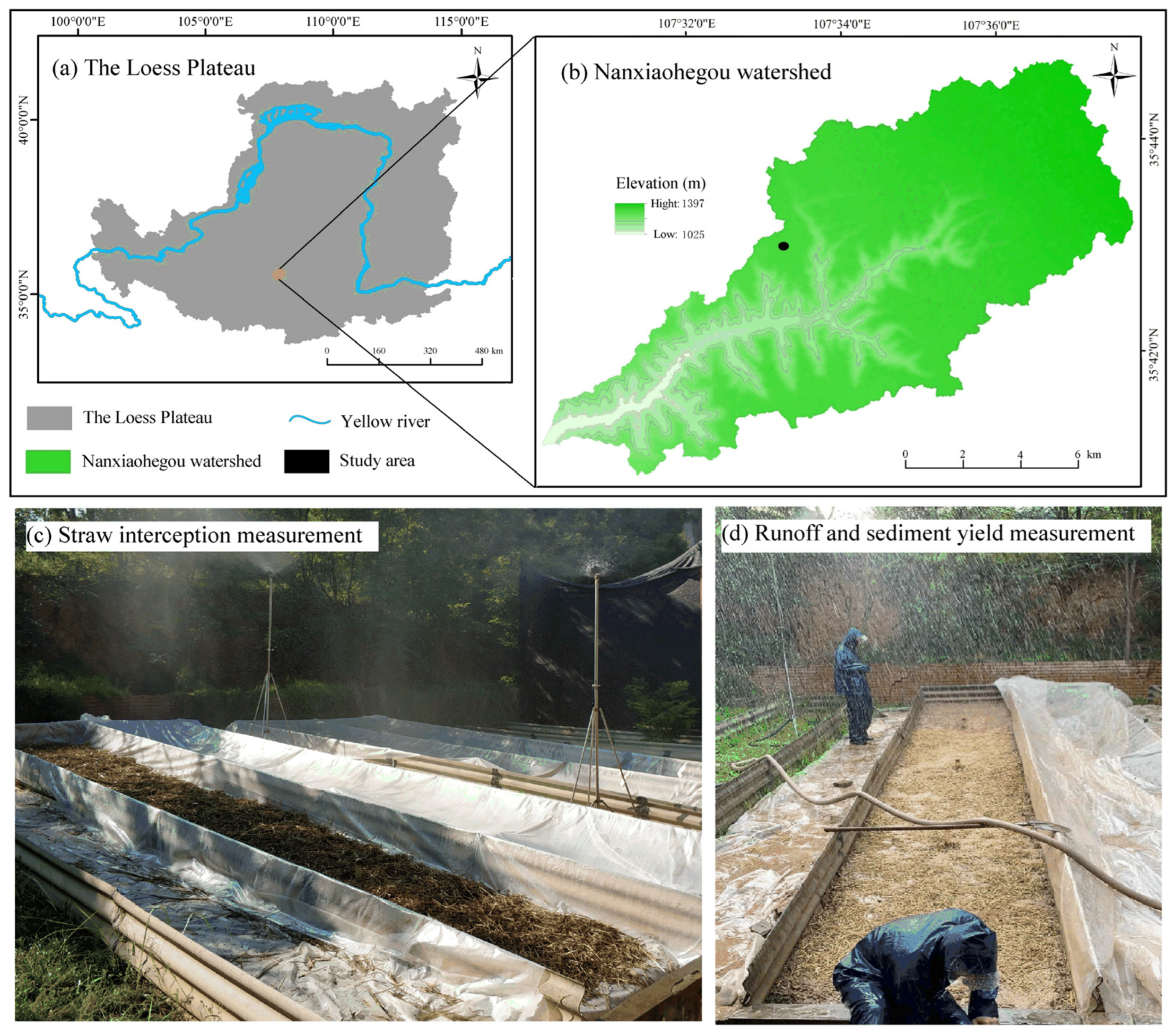
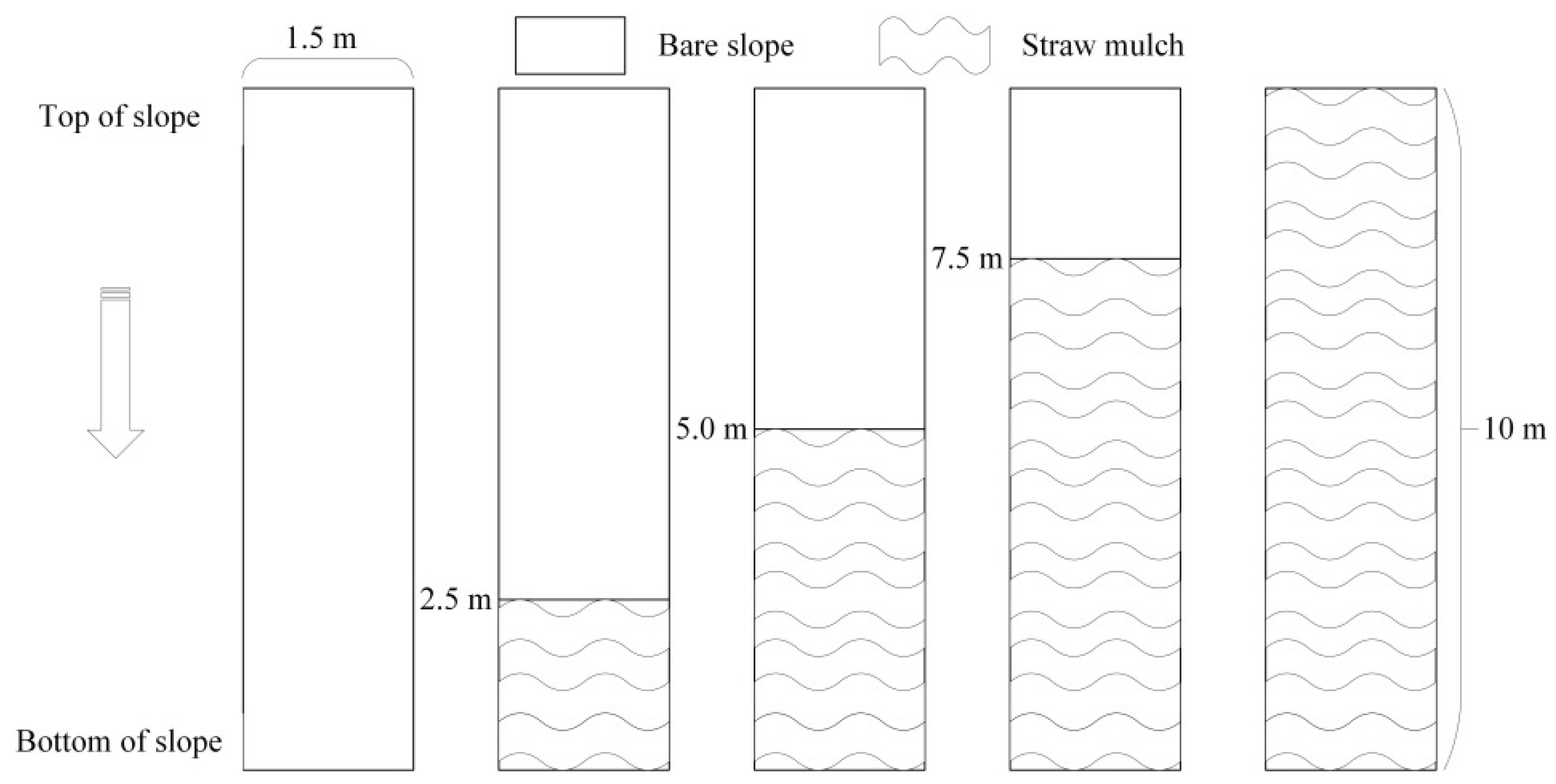

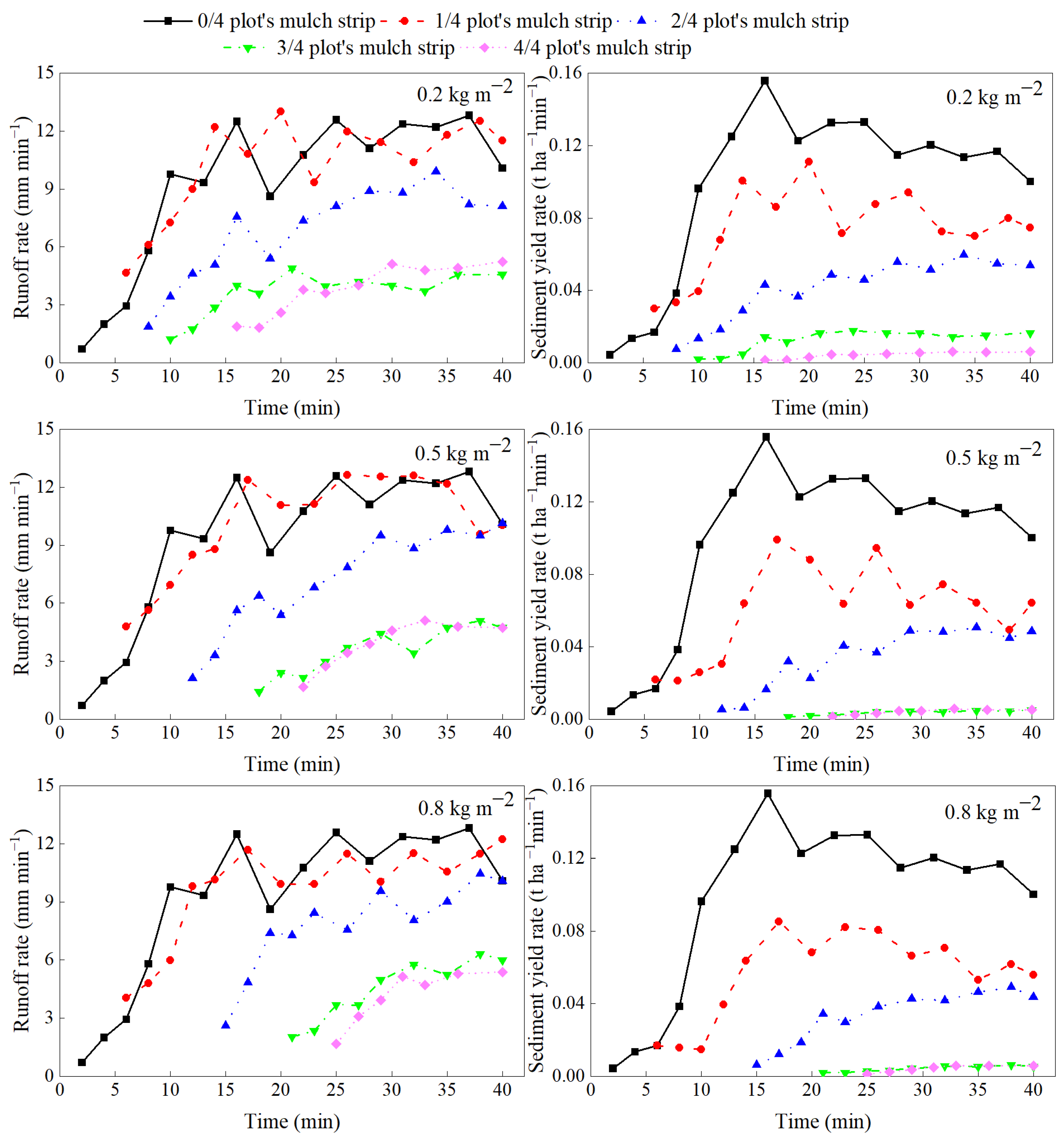

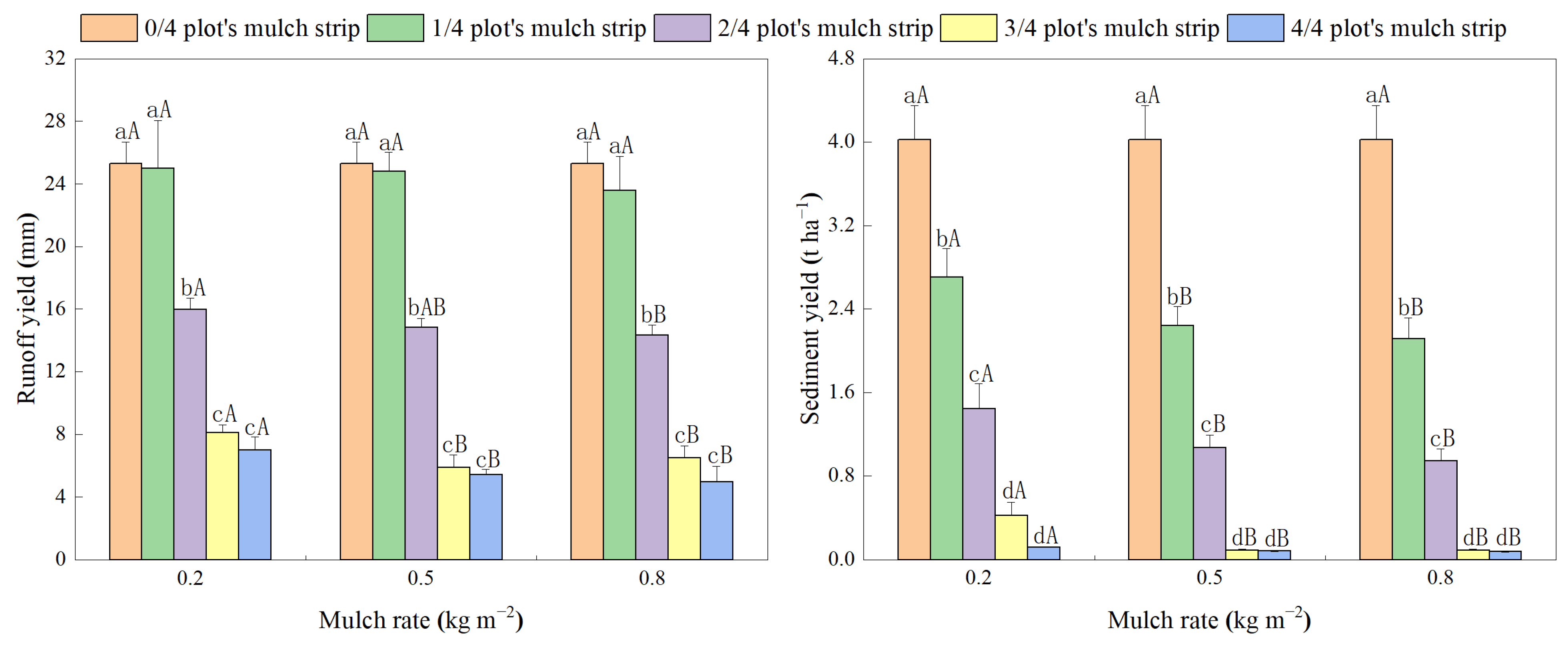
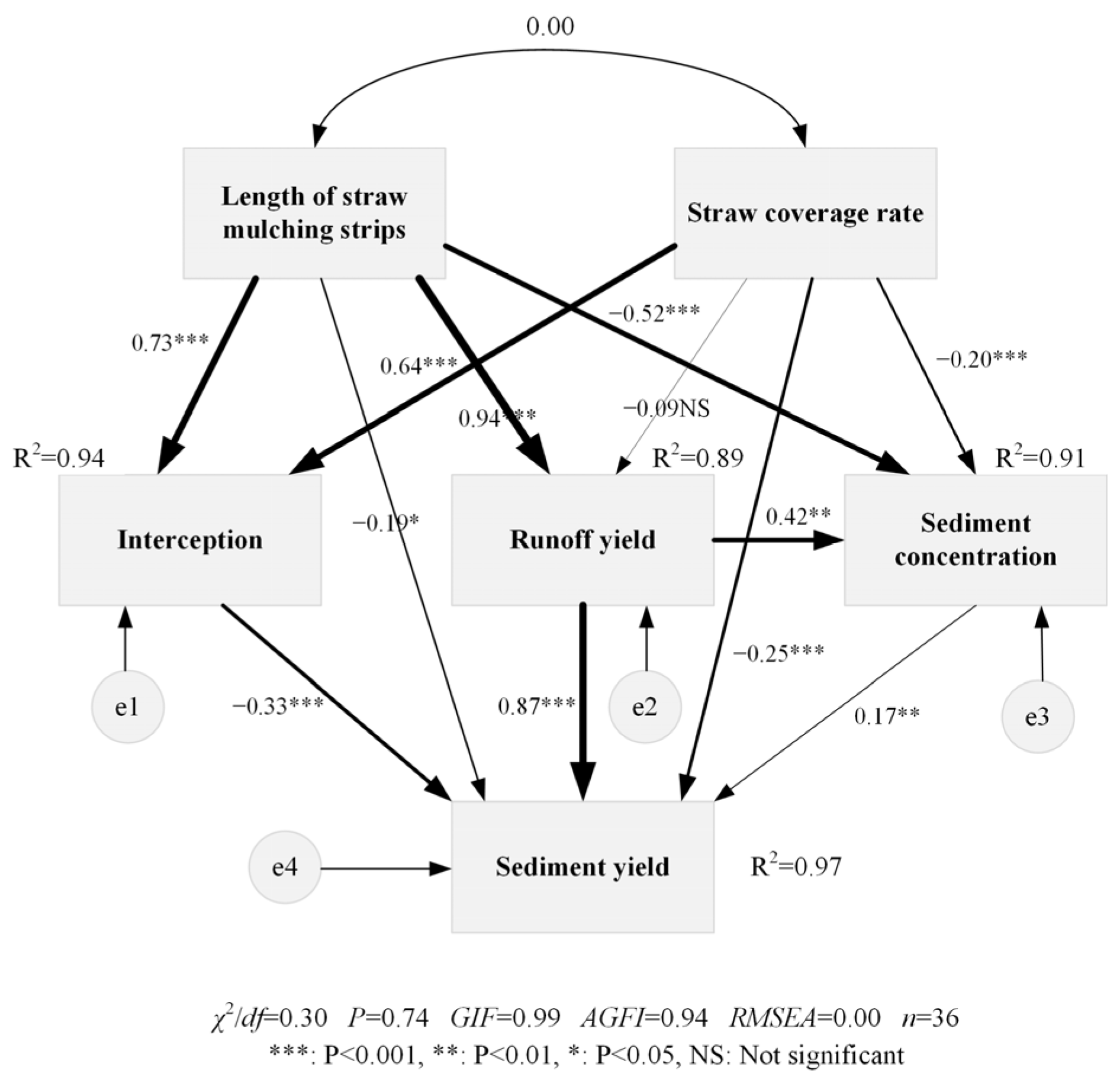
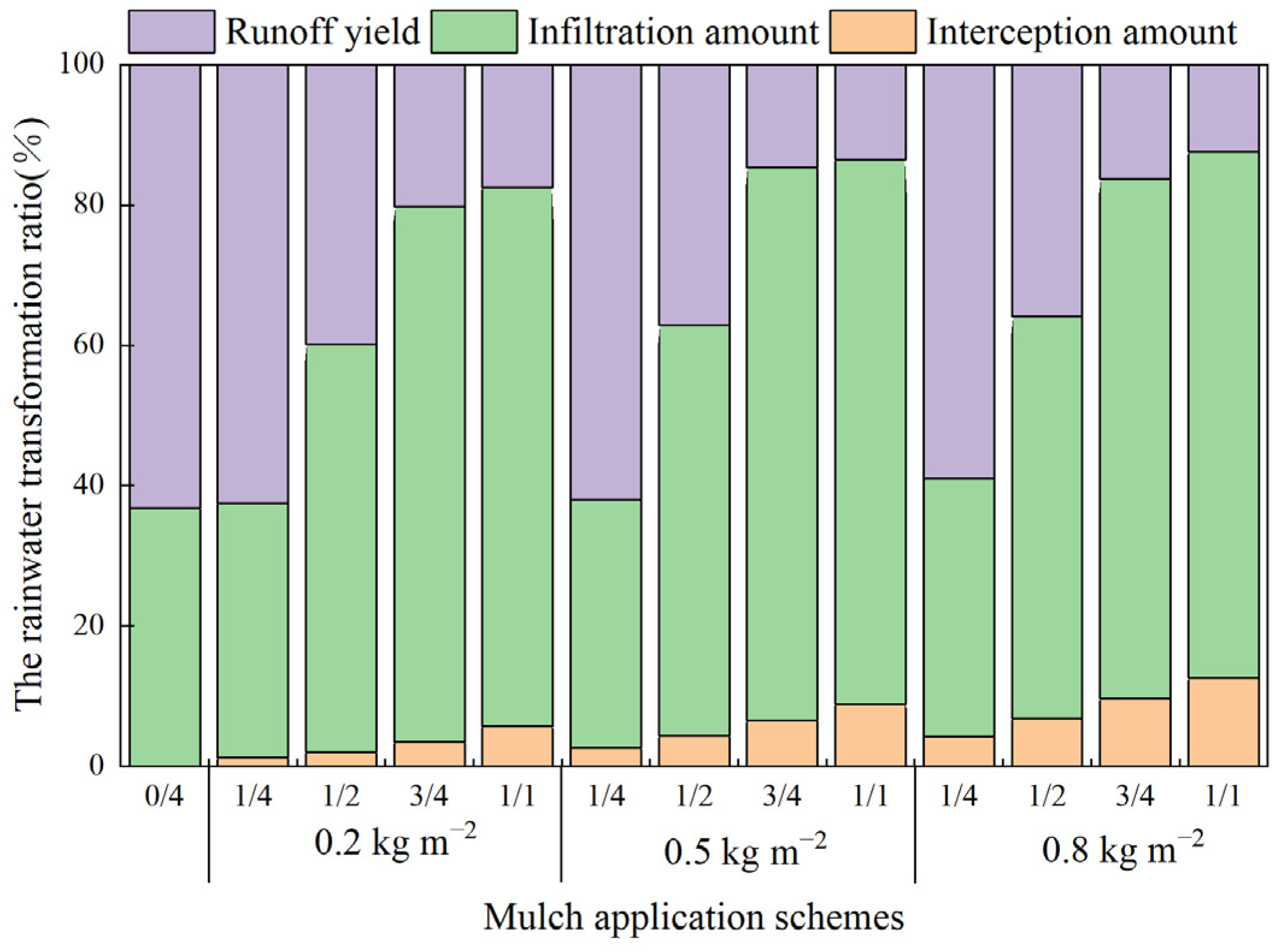

| Clay (%) <2 μm | Silt (%) 2–50 μm | Sand (%) 50–2000 μm | Soil Texture | Bulk Density (g cm−3) | Organic Carbon (g kg−1) | Ph |
|---|---|---|---|---|---|---|
| 10.8 ± 1.2 | 32.3 ± 2.2 | 56.9 ± 2.7 | Sandy loam | 1.3 ± 0.1 | 6.4 ± 0.9 | 8.5 ± 0.3 |
| Coverage Rate (kg m−2) | Initial Runoff Time (s) | |||
|---|---|---|---|---|
| 1/4 Plot’s Mulch Strip | 1/2 Plot’s Mulch Strip | 3/4 Plot’s Mulch Strip | 1 Plot’s Mulch Strip | |
| 0 | 61.2 ± 11.4 aA | 61.2 ± 11.4 aA | 61.2 ± 11.4 aA | 61.2 ± 11.4 aA |
| 0.2 | 335.4 ± 30.2 bA | 439.7 ± 40.6 bAB | 559.8 ± 38.8 bB | 939.0 ± 196.7 bC |
| 0.5 | 356.3 ± 93.8 bA | 705.7 ± 139.4 cB | 1057.6 ± 176.6 cC | 1304.4 ± 227.6 cC |
| 0.8 | 369.1 ± 65.6 bA | 873.5 ± 154.1 cB | 1220.2 ± 233.5 cC | 1500.4 ± 253.1 cC |
| Variable | Direct Effects | Indirect Effects | Total Effects |
|---|---|---|---|
| Straw coverage rate | −0.25 | −0.09 | −0.34 |
| Length of straw mulching strips | −0.19 | −0.74 | −0.93 |
| Runoff yield | 0.86 | 0.072 | 0.95 |
| Sediment concentration | 0.17 | 0 | 0.17 |
| Interception | −0.33 | 0 | −0.33 |
| Mulch Rate (kg m−2) | Length of Straw Mulching Strips | c | R2 | NSE |
|---|---|---|---|---|
| 0.2 | 1/4 plot | 0.14 | 0.95 | 0.84 |
| 2/4 plot | 0.25 | 0.91 | 0.75 | |
| 3/4 plot | 0.36 | 0.94 | 0.8 | |
| 4/4 plot | 0.43 | 0.96 | 0.89 | |
| 0.5 | 1/4 plot | 0.28 | 0.94 | 0.8 |
| 2/4 plot | 0.33 | 0.96 | 0.86 | |
| 3/4 plot | 0.53 | 0.96 | 0.83 | |
| 4/4 plot | 0.67 | 0.95 | 0.8 | |
| 0.8 | 1/4 plot | 0.26 | 0.95 | 0.82 |
| 2/4 plot | 0.51 | 0.97 | 0.88 | |
| 3/4 plot | 0.69 | 0.98 | 0.93 | |
| 4/4 plot | 0.73 | 0.97 | 0.89 |
Disclaimer/Publisher’s Note: The statements, opinions and data contained in all publications are solely those of the individual author(s) and contributor(s) and not of MDPI and/or the editor(s). MDPI and/or the editor(s) disclaim responsibility for any injury to people or property resulting from any ideas, methods, instructions or products referred to in the content. |
© 2024 by the authors. Licensee MDPI, Basel, Switzerland. This article is an open access article distributed under the terms and conditions of the Creative Commons Attribution (CC BY) license (https://creativecommons.org/licenses/by/4.0/).
Share and Cite
Zhao, X.; Song, X.; Wang, D.; Li, L.; Meng, P.; Fu, C.; Wang, L.; Wei, W.; Yang, N.; Liu, Y.; et al. Optimizing Straw Mulching Methods to Control Soil and Water Losses on Loess Sloped Farmland. Agronomy 2024, 14, 696. https://doi.org/10.3390/agronomy14040696
Zhao X, Song X, Wang D, Li L, Meng P, Fu C, Wang L, Wei W, Yang N, Liu Y, et al. Optimizing Straw Mulching Methods to Control Soil and Water Losses on Loess Sloped Farmland. Agronomy. 2024; 14(4):696. https://doi.org/10.3390/agronomy14040696
Chicago/Turabian StyleZhao, Xinkai, Xiaoyu Song, Danyang Wang, Lanjun Li, Pengfei Meng, Chong Fu, Long Wang, Wanyin Wei, Nan Yang, Yu Liu, and et al. 2024. "Optimizing Straw Mulching Methods to Control Soil and Water Losses on Loess Sloped Farmland" Agronomy 14, no. 4: 696. https://doi.org/10.3390/agronomy14040696




